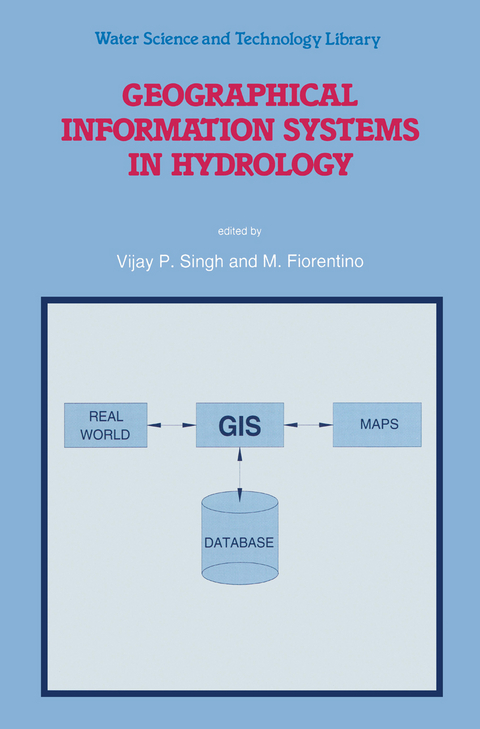
Geographical Information Systems in Hydrology
Seiten
2010
|
Softcover reprint of hardcover 1st ed. 1996
Springer (Verlag)
978-90-481-4751-9 (ISBN)
Springer (Verlag)
978-90-481-4751-9 (ISBN)
The last few years have witnessed an enormous interest in application of GIS in hydrology and water resources. The integration involves three major components: (1) spatial data construction, (2) integration of spatial model layers, and (3) GIS and model interface.
The last few years have witnessed an enormous interest in application of GIS in hydrology and water resources. This is partly evidenced by organization of sev eral national and international symposia or conferences under the sponsorship of various professional organizations. This increased interest is, in a large measure, in response to growing public sensitivity to environmental quality and management. The GIS technology has the ability to capture, store, manipulate, analyze, and visualize the diverse sets of geo-referenced data. On the other hand, hydrology is inherently spatial and distributed hydrologic models have large data requirements. The integration of hydrology and GIS is therefore quite natural. The integration involves three major components: (1) spatial data construction, (2) integration of spatial model layers, and (3) GIS and model interface. GIS can assist in design, calibration, modification and comparison of models. This integration is spreading worldwide and is expected to accelerate in the foreseeable future. Substantial op portunities exist in integration of GIS and hydrology. We believe there are enough challenges in use of GIS for conceptualizing and modeling complex hydrologic processes and for globalization of hydrology. The motivation for this book grew out of the desire to provide under one cover a range of applications of GIS tech nology in hydrology. It is hoped that the book will stimulate others to write more comprehensive texts on this subject of growing importance.
The last few years have witnessed an enormous interest in application of GIS in hydrology and water resources. This is partly evidenced by organization of sev eral national and international symposia or conferences under the sponsorship of various professional organizations. This increased interest is, in a large measure, in response to growing public sensitivity to environmental quality and management. The GIS technology has the ability to capture, store, manipulate, analyze, and visualize the diverse sets of geo-referenced data. On the other hand, hydrology is inherently spatial and distributed hydrologic models have large data requirements. The integration of hydrology and GIS is therefore quite natural. The integration involves three major components: (1) spatial data construction, (2) integration of spatial model layers, and (3) GIS and model interface. GIS can assist in design, calibration, modification and comparison of models. This integration is spreading worldwide and is expected to accelerate in the foreseeable future. Substantial op portunities exist in integration of GIS and hydrology. We believe there are enough challenges in use of GIS for conceptualizing and modeling complex hydrologic processes and for globalization of hydrology. The motivation for this book grew out of the desire to provide under one cover a range of applications of GIS tech nology in hydrology. It is hoped that the book will stimulate others to write more comprehensive texts on this subject of growing importance.
1 Hydrologic modeling with GIS.- 2 Integration of Remote Sensing and GIS for Hydrologic Studies.- 3 Hydrologic Data Development.- 4 Spatial Data Characteristics.- 5 Methods For Spatial Analysis.- 6 GIS Needs and GIS Software.- 7 Digital Terrain Modelling.- 8 GIS for Distributed Rainfall — Runoff Modeling.- 9 GIS for Large-Scale Watershed Modelling.- 10 Lumped Modeling and GIS in Flood Prediction.- 11 GIS in Groundwater Hydrology.- 12 Nonpoint Source Pollution Modeling (with GIS).- 13 Soil Erosion Assessment Using G.I.S..- 14 A Study of Landslides Based on GIS Technology.- 15 Land-Use Hydrology.- 16 Design of GIS for Hydrological Applications.- List of Contributors.
| Erscheint lt. Verlag | 6.12.2010 |
|---|---|
| Reihe/Serie | Water Science and Technology Library ; 26 |
| Zusatzinfo | XVI, 446 p. |
| Verlagsort | Dordrecht |
| Sprache | englisch |
| Maße | 160 x 240 mm |
| Themenwelt | Naturwissenschaften ► Biologie ► Ökologie / Naturschutz |
| Naturwissenschaften ► Geowissenschaften ► Geologie | |
| Naturwissenschaften ► Geowissenschaften ► Hydrologie / Ozeanografie | |
| Naturwissenschaften ► Geowissenschaften ► Meteorologie / Klimatologie | |
| Technik ► Bauwesen | |
| ISBN-10 | 90-481-4751-4 / 9048147514 |
| ISBN-13 | 978-90-481-4751-9 / 9789048147519 |
| Zustand | Neuware |
| Informationen gemäß Produktsicherheitsverordnung (GPSR) | |
| Haben Sie eine Frage zum Produkt? |
Mehr entdecken
aus dem Bereich
aus dem Bereich
Planung · Recht · Verfahren
Buch | Hardcover (2024)
Springer Vieweg (Verlag)
64,99 €
Lehrbuch zu Grundlagen, Technologie und Praxis
Buch | Hardcover (2022)
Hanser (Verlag)
34,99 €


